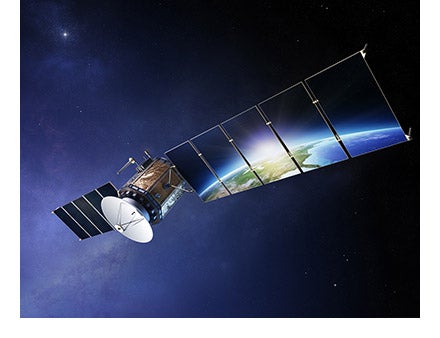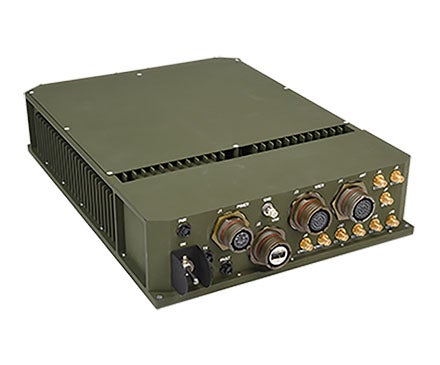Achieving the vision of multi-orbit, multi-constellation transport diversity with traditional approaches means racks of hardware-based, constellation-unique system solutions that are space consuming, power hungry and cumbersome to manage. A solution that effortlessly scales, fits in a smaller footprint and seamlessly integrates new constellations will set the pace for delivering on the vision.
A software-defined – not hardware-constrained – approach is needed to truly realize the potential in defense applications of the multi-constellation commercial Satellite Communications (SATCOM) market. This concept, known as Virtualized SATCOM, leverages advances in virtual production server technology, waveform virtualization, advances in software-defined wide-area networking and smart-blending technologies to enable software-based processing in what has traditionally been accomplished by single-purpose SATCOM server hardware.
The virtualization of SATCOM connectivity enhances resilient communications by delivering multi-path, multi-orbit and multi-constellation transport diversity – expanding options in PACE (Primary, Alternate, Contingency and Emergency) planning.

“Adversaries are continuing to evolve their defenses against traditional military Satellite Communications, wideband global SATCOM and emerging spaceborne assets,” said Brendan O’Connell, L3Harris president of Broadband Communications Systems. “True resilient communication requires alternate solutions outside what has been traditional methods of delivering resilient beyond-line-of-site communications. Through SATCOM virtualization, operators can use any and all networks available to them, and they don’t need to worry about where to host 50 one-off servers to support them all.”
The inherent ability to scale the virtualized system provides advanced capability with dynamic software, better use of applications and a more-ubiquitous data flow to the user, added O’Connell. Further, SATCOM virtualization reduces server-room space constraints, energy costs and heat signatures.
“L3Harris is a trusted partner with our customer to deliver this capability,” said O’Connell. “A key to this is integrating Over-the-Air (OTA) testing with our strategic waveform virtualization. This ensures real, dynamic testing on operational networks to show viability and reliability of the capability, not just on slides or in a lab. While we have a proven development and testing process that involves lab testing for risk reduction, we always drive to live OTA testing as part of the design process.”
As such, the path forward for SATCOM virtualization includes harnessing the best-of-breed capabilities currently fielded and integrating them with new software to extend existing communications ecosystems. The company ports software solutions for software-defined wide-area networking and smart-blending to current systems and incorporate software upgrades into scheduled patches.
Proving the Concept
L3Harris will deliver two virtualized Satellite Communications ground system prototypes to U.S. Army Combat Capabilities Development Command to demonstrate the increased capacity and pathway diversity of SATCOM virtualization. A dual Low-Earth Orbit (LEO)-Medium-Earth Orbit (MEO) waveform as well as a trusted Military SATCOM (MILSATCOM) asset will be used in the respective systems, highlighting the flexibility of this first-to-market solution to scale down the SWaP-C (Size, Weight and Power – Cost) of multi-carrier, multi-capability space-based communications.
Network Command, Control, Communication, and Intelligence Cross-Functional Team (N-CFT), established by the Army’s Future Command, awarded L3Harris the program contract in July 2022 with prototype deliveries scheduled for 2024.
“This program gives us the ability to prove our technologies in a government environment – to develop and mature them with government collaboration – to ensure we develop the right capability for and with the warfighter,” said Tom Kirkland, L3Harris vice president and general manager of U.S. Army and Special Operations Command programs. “The virtualization of these strategic waveforms through digital infrastructures allows one centralized laptop to process what used to require up to eight single-purpose modems.”
Supporting Efforts

Multi-Constellation Modem (MCM-500)
L3Harris’ approach to SATCOM virtualization is to build upon proven protected MILSATCOM from GEO and extend it to other orbits with the company’s Multi-Constellation Modem (MCM) and Field-Programmable Gate Arrays (FPGAs). This creates more of an open standard that commercial satellite internet providers can leverage to support defense SATCOM networks.
Progress toward these efforts was accelerated during L3Harris’ participation in the U.S. Air Force Defense Experimentation Using Commercial Space Internet (DEUCSI) program, which aims to develop multi-constellation communications through commercial providers that deliver resilient, high-bandwidth, high-availability communications and data-sharing capabilities.
“Virtualization gives us more options in constellation diversity,” said Kirkland. “Both the need for and capability of diverse commercial space internet (CSI) connectivity are hard problems the government is just starting to explore, but this software-based approach is already showing a great deal of promise.”
L3Harris’ Virtual SATCOM capability will be tested over a live commercial satellite constellation in 2023, and the company plans to provide interested customers demonstrations early next year as well.
